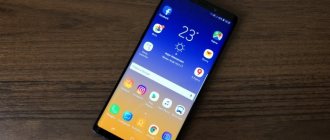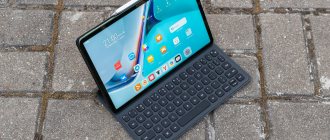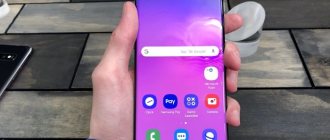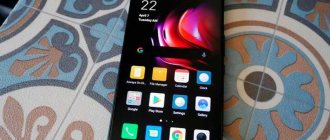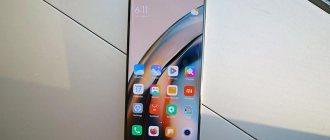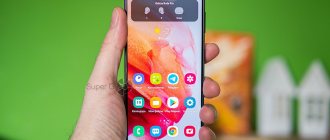About 3 months ago, the Chinese company OnePlus, whose roots grow from Oppo, announced the One Android communicator on April 23 in Beijing, relying on a combination of top-notch hardware, high-end software and a more than affordable price. Probably, almost everyone who is interested in new products in the mobile industry knows about the new device. A frantic excitement, a huge number of thoughts and impressions immediately appeared on the Internet after the release of the gadget. Many were even ready to break their smartphone for a cool new product!
But why is OnePlus One so interesting? Why is it called the flagship killer? And where can you buy this miracle? Let's figure it out together!
▌TECHNICAL SPECIFICATIONS
OnePlus One is equipped with a quad-core Qualcomm Snapdragon 801 (8974AC) processor clocked at 2.5 GHz, 3 GB of RAM and a high-quality 5.5-inch Full HD display manufactured by JDI, protected by Gorilla Glass 3. The new product runs on Android 4.4 KitKat with special modified CyanogenMod 11S shell.
Other OnePlus One specifications include NFC, Wi-Fi (2.4G/5G) 802.11 b/g/n/ac, Bluetooth 4.0, GPS, 4G (LTE) support, and JBL stereo speakers.
Screen:
5.5″, 1920×1080 px, FHD, LTPS IPS
Processor:
Qualcomm Snapdragon 801 (Krait 400, 2.5 GHz, 4 cores)
Video accelerator:
Adreno 330 578MHz
Operating system:
CyanogenMod 11S based on Android 4.4
RAM:
3 GB
User memory :
16 GB / 64 GB eMMC 5.0
Camera:
front - 5 MP, rear - 13 MP
Communication:
1 SIM card (GSM/GPRS/EDGE + UMTS/HSPA + LTE)
Additionally:
GPS, A-GPS, GLONASS, Wi- Fi, Bluetooth, NFC, OTG, accelerometer, gyroscope, compass, indicator, light and distance sensor
Battery:
3100 mAh
Dimensions:
152.9 x 75.9 x 8.9 mm
Weight:
162 Grams
Price:
$357 - 16 GB (~ 12,500 rubles)
|
$425 – 64 GB (~ 14,900 rubles)
Interface
The main feature of OnePlus One is that it runs on CyanogenMod out of the box. This is perhaps the most famous “build” of Android with advanced capabilities. Among the features worth noting is the ability to customize shortcuts on the lock display, and the choice of a proprietary “lock screen”. The interface design is very beautiful and easy to use. You can set your own format in which the level of charge and network reception will be entered. You can hide labels for icons, and increase the size of the icons themselves. You can customize almost every element in the status bar and even hide the clock display. Design themes can be combined with each other, using fonts from one theme and animation from another.
Conclusion
The volume of the multimedia speaker is above average, and there are no complaints about the quality of signal reception. The cost of the device today is 16,000 rubles, which is quite good for such characteristics that remain relevant even to this day. For this money you get a device with a high-quality screen, support for modern communication standards, excellent battery life and productive hardware. Another advantage is that you can freely find a huge number of firmwares that introduce new features to the system.
Where can I buy?
- You can purchase a modification for 16 GB of internal memory here Aliexpress
- The 64 GB version is available on Aliexpress at this link
OnePlus 5T - is it worth upgrading to the updated version of the flagship killer?
OnePlus 3T is an updated version of the flagship killer. Is it worth the $40 overpayment?
OnePlus 5 - how successful was the next flagship killer?
Full review of OnePlus 7 Pro - we look at all the pros and cons of the smartphone
OnePlus 6 - the flagship killer once again confirms its title, delighting with an excellent price-performance ratio
▌PACKAGING AND EQUIPMENT
The company has thought through everything to the smallest detail.
And even the delivery box has its own design. The box was still packed in a gray bag with a layer of bubble wrap inside. To open it you just need to pull the string. Although I didn’t know about it and simply cut the tape that closed the box with a knife.
There are two more boxes neatly laid out in it, one with the device and accessories, and the other with the charger. To prevent the remaining space from being empty, we also put in a foam plug.
Let's start with the most interesting thing - the box with the power supply. It also looks quite stylish in the company’s signature colors and has the silhouette of a charger.
Specifications are listed on the back.
The power adapter body is made of high-quality plastic, the surface is smooth to the touch.
The power supply outputs 2A, the smartphone charges in about 2 and a half hours.
And here we have the right box with something interesting inside. The smartphone comes in a chic white box, inside of which there is a second red box, one “drives” into the other.
The device itself is contained in a thin red box, about 2 centimeters thick, as are the main accessories.
The box opens like a book. Inside, on the top level, the device lies neatly.
At the lower level, accessories are laid out very effectively. There is a red microUSB cable and a metal clip for removing the SIM card tray in an individual plastic case with a metal loop for attaching to a keychain; no headphones are included. There is also an instruction manual, which you can throw away, since it is entirely in Chinese, and leave the envelope, it is beautiful.
The guys from OnePlus really tried to do everything at the highest level, paying special attention to packaging and accessories. Every element of the box, every accessory inside literally screams about how high-quality the product you are holding in your hands.
[edit] Notes
- Subsequently it turned out that OnePlus is just another “daughter” of VVK
- [1]
- [2]
- [3]
- [4]
- [5]
- example
| Characteristics of OnePlus One refers to the topic "4PDA" | |
| w3bsit3-dns.com (Navigation • Tekhnotrepalka • Trepalka • Meat grinder • School of the Curator • Complain against incorrect actions of Moderators • Bug tracker) • Brotherly projects (DevDB • DevFAQ • DevSale) • News sections w3bsit3-dns.com | |
| Participant groups | Unactivated • Users • Active users • Friends of w3bsit3-dns.com • Special project participants • FAQmakers • Developers • Businessmen • Honorary members of the forum • Moderator assistants • Moderators • Super moderators • Routers • Admins • Banned • Topic curator |
| Administration | Imater • tab • Smartecs • qq1978 • -QwertY- • Gridzilla • Black moderator |
| Participants | Fred the Star Seller (Lindström) • CavalierXXI • corola • Razoblachitel • Bilderling • VadZay |
| Events | April 1 • Advertising campaigns • Competitions • W3bsit3-dns.com Award |
| Incidents | Do you see the ram? And we see! • Design update • Gameloft against w3bsit3-dns.com • DDOS attack on w3bsit3-dns.com • Ban on publishing referral links • Admin pogrom |
| Memes | Rules 4.21 • Characteristics of OnePlus One • Homosexual conspiracy Party operators w3bsit3-dns.com |
▌DESIGN, DIMENSIONS, CONTROL ELEMENTS
The appearance of OnePlus One is simple and sleek.
On the front panel you will not find any company logo, no mechanical buttons, or speakers on the edges. There is, perhaps, a small recess between the protective glass of the screen and the metal frame around it. I’m glad that the company did not take the path of copying the design, as many Chinese do . Nearby there is an indicator that lights up in different colors. Moreover, for example, when charging, the green color changes its hue from dim to bright as the charge level increases; it also has many more features related to settings for each application. In the middle is the earpiece, which is covered with a fine mesh
Below are barely noticeable hardware buttons, which are also backlit, but only in one color - blue. The company apparently did not pay special attention to these controls, because in the settings you can choose which buttons to use - on-screen or touch.
So it is immediately recommended to learn the functions of the buttons by heart, since in daylight they are not visible at all. On the other hand, they are readable in twilight and darkness quite comfortably.
On the left side there is a volume rocker and a tray for a microSIM card. The SIM card tray is made of plastic; it can be easily removed using the included clip and can also be easily snapped back into place.
On the right is the power and lock button. You rarely use it, because the screen can be woken up by double tapping anywhere on the panel, and also made to go back to sleep. The buttons are thin, small and tight. They are easy to feel in your pocket and quite difficult to press inadvertently.
The back cover is decorated with an engraved OnePlus logo in black. The back panel material is called “silk white”, it is really very pleasant to the touch. Reminiscent of the effect of soft-touch plastic, but without the obvious presence of rubber. If all manufacturers made their smartphones from the same pleasant plastic, then the ranks of aluminum fans would thin out significantly. On the back cover there is also a 13 megapixel camera from Sony with dual LED flash. A microphone is used to capture sound and reduce noise when recording video.
At the bottom, the whole impression is spoiled by Chinese inscriptions. But you can only find them if you order a smartphone from a Chinese store. If you buy the device from the official website via invite, the back cover will be decorated with the stylish Cyanogen inscription! The cover of the device is removable, but the battery itself is not. On the official website you can order different options for finishing the back cover, like the Moto X - wood, fabric and others. By the way, the black OnePlus One is made of plastic that is rough and velvety to the touch, but the rest of the material is also practical, so you should choose between colors carefully; the texture of the cover will be different.
On the top edge there is a 3.5 mm jack for connecting a headset and an additional microphone hole. It is worth noting that OnePlus One is one of the few smartphones equipped with three microphones for surround sound capture from all directions. If you look at the profile, you will notice that the body has a curved shape, making it more comfortable in the hand.
And below, the user will see stereo music speakers developed by JBL, a microUSB interface and a conversational microphone. The sound quality can be called high; it should be admitted that the volume level of the speakers is very good and its owner can easily hear the call even in a busy square.
Whether someone likes it or not, today a smartphone with a 5.5-inch screen is a completely normal trend. OnePlus One is one of the largest smartphones on the market. When you pick it up, it feels quite huge, especially considering the bezels around the entire perimeter of the device. If you have never used smartphones with large displays before, then I advise you to definitely hold similar models in your hands before purchasing - Samsung Galaxy Note 3 or LG G3. Nevertheless, the device fits perfectly in the palm of your hand, although it is more convenient to use and type with two hands. There are no complaints about the build quality itself, everything is done at a high level, nothing creaks or plays, there are no gaps between the elements.
Model features
It seems incredible that a company that no one had heard of a year ago managed to create a smartphone that was talked about no less than Apple devices. However, if you delve a little deeper into the history of the OnePlus brand, it will quickly become clear that the 1+One model did not appear out of nowhere. The company belongs to the BBK concern and makes full use of its developments. However, all this does not negate the fact that the first smartphone really turned out to be successful.
The key feature of the OnePlus One is its price. It is one and a half to two times lower compared to flagships, such as the Samsung Galaxy Note 3. However, it is not entirely clear how such significant savings were achieved. The device is built on a powerful modern platform, is well assembled, has a good screen and a decent camera.
The manufacturer skillfully stirred up interest in the new product by publishing fragmentary information about it and promising top-end performance at a minimal price. An unusual invitation system was used to organize sales. Everyone had to get an invite (they were given out for participating in various competitions), and only after that the device was shipped to him for some time.
There was an immediate shortage of devices on the market, which led to the emergence of resellers selling devices at a higher price. However, it still remained noticeably lower in comparison with top-end smartphones from other manufacturers.
The original sales system lasted for about a year and throughout this time there was significant demand for the device. Interestingly, in China the phone immediately went on sale for free, while buyers from other countries had to receive invites.
Housing materials and dimensions
The body is plastic, but the phone's chassis is made of magnesium alloy. There is a visible metal frame around the protective glass. The body can be white or black. At the same time, black plastic is rough to the touch, while white has a matte, smooth surface. Phones of different colors feel different in your hands, but fingerprints and marks on the surface of the white and black cases are almost invisible.
Overall dimensions are 153x76x8.9 mm. The device is not the thinnest, but this did not affect the ergonomics in any way. Rather, on the contrary, this thickness is optimal, allowing you to firmly hold the smartphone in the palm of your hand. The length of the device turns out to be larger than, for example, the Galaxy S5 or HTC OneM8. However, it has a larger screen, so the difference in size is understandable.
Build quality
There are no creaks or backlashes, although the body is plastic. Moreover, it seems monolithic and inseparable, although this is not entirely true. You can still remove the back cover, and you don’t even have to use any tool to do this. And yet, the build quality is very high, all parts fit tightly together, there are no gaps, and the buttons do not dangle. Overall, the OnePlus One is very different from most Chinese phones. No wonder it is praised in the vast majority of reviews.
Positioning
OnePlus was solving two complex problems at the same time. She needed to release a phone that was not like most Chinese clones. The aggressive marketing campaign bore fruit - the smartphone managed to attract the attention of millions of potential customers.
The second problem was that the smartphone had to not only be remembered for its appearance, but also impress everyone with its hardware and low cost.
There is no doubt that the company had to make a lot of effort to get top-end components (primarily the processor and memory), while maintaining a very attractive price. How this was achieved is unknown, but the fact remains. The OnePlus One delivers excellent performance in tests while its price is very competitive.
As a result, a real “flagship killer” appeared. There was a lot of talk that the Chinese would not be able to ensure high build quality or that the phone would never be available for sale. However, these assumptions turned out to be incorrect. The first model a0001 created a sensation.
▌DISPLAY
The smartphone screen has a diagonal of 5.5 inches and FullHD resolution, the pixel density is 401 PPI. It uses a high-quality LTPS IPS matrix, providing a wide color gamut and close to maximum viewing angles. Of course, the display is protected by Corning Gorilla Glass 3.
The display is made using the TOL (touch on lens) approach, which reduces the number of screen layers by combining them: images become closer to the user, their brightness increases, and the parallax effect is eliminated.
The thickness of the side frames from the edge of the screen to the edge of the body is approximately 3 mm - the frames are narrow, and against the backdrop of the overall considerable dimensions of the device they seem even thinner.
The display brightness can be adjusted manually, or you can use automatic adjustment. Multi-touch technology here allows you to process up to 10 simultaneous touches. The touchpad only responds to fingers; operation with gloves is not provided.
OnePlus One smartphone review
I’ll say right away that it’s quite difficult to surprise me with some new smartphone. Of course, I am by no means a leading mobile analyst - I do not have the depth of knowledge of this market, like, for example, Eldar Murtazin - and my sphere of interests is much wider and, accordingly, I swim much more shallowly, but further, however I follow smartphones quite closely and usually test most of the really interesting new products. Some new items are sent by manufacturers, others are sent by an old partner, the online store Yulmart, and others I simply purchase myself - well, just so as not to wait for favors from nature.
So, I heard about the OnePlus One smartphone of Chinese origin from a friend who has been living in the United States for more than ten years. When asked what exactly attracted him to this smartphone in a country where these smartphones are at the most attractive prices - you can even plant them in the garden beds, the friend replied that the smartphone has characteristics that are not inferior to those of flagships from top manufacturers, but at the same time it is thin, stylish, and The main thing is that it costs almost twice as much.
And I have long since formed a very clear attitude towards cheap Chinese unknown devices (smartphones, tablets), which are “almost the same as the flagships of top companies, only they cost much less.” I have repeatedly tested these devices and came to the conclusion that they are worth their money: that is, if you are offered an “analogue of the Samsung Galaxy Note 3” at a price three times cheaper, then you can be firmly confident that this “analog” will be quite terrible and its cost will in no way exceed the money that is being asked for it. That is, there are no “complete analogues that are 2-3 times cheaper” - it’s like with fake Swiss watches.
However, well-established Chinese brands are a completely different matter. Because Huawei, Lenovo, Meizu, Xiaomi are more than worthy manufacturers who very successfully go their own way and produce devices that can compete with products from Samsung, Sony, LG, HTC and so on. Moreover, the same Huawei company released the Huawei Ascend Mate 7 smartphone, which I personally consider to be the coolest smartphone on the market at the moment - and I have not yet changed my opinion even after getting acquainted with the latest flagships of competitors.
But what is OnePlus One?.. After I heard about this brand, I started reading the history of the brand.
Briefly, the story is simple. Pete Lau was the vice president of the Chinese company Oppo, a fairly well-known manufacturer of high-end smartphones. Lau was one of the heads of the division that produces Blu-ray players. Pete Lau
At the end of 2013, Pete Lau leaves Oppo and announces the creation of OnePlus, which should focus on releasing a new smartphone - cool, inexpensive, innovative, and so on.
Next, Pete Lau put on a whole show on the Internet in the process of creating a new smartphone: users could follow the creation of a new device literally in real time, while the company’s forum, blogs, and so on were actively working - well, journalists also quickly became interested in this project and a lot about they wrote to him.
OnePlus also actively used feedback from users, launched all sorts of competitions and other means of promotion, ensuring that the OnePlus brand was seriously talked about even before the appearance of this smartphone.
And when it appeared, it immediately became clear that, dear friends, why don’t you just buy it - no, it won’t work: first you need to get an invite, and how to get it - go through a quest on the manufacturer’s website. And this also greatly fueled interest.
To be honest, I personally don’t play these games and don’t plan to play, so I didn’t go through any quests and didn’t receive an invite, but in old Europe everything was much simpler with this matter: pay a little more (366 euros instead of $400) and get a phone number without all sorts of invitation quests.
(In an epic voice.) And I ordered it, and I received it, and I studied it for a month and a half - and now I’m ready to share my impressions. Go.
Specifications
Operating system:
Android 4.4.4 (CyanogenMod 11S)
Processor:
Qualcomm Snapdragon 801, 2.5GHz, quad-core
Display:
5.5″, JDI, 1920×1080, LTPS IPS with TOL, 401 PPI, Gorilla Glass 3
RAM:
3 GB
Flash memory:
16/64 GB
SIM:
microSIM
Memory card:
no
Network:
GSM: 850, 900, 1800, 1900MHz, WCDMA: Bands: 1/2/4/5/8, LTE: Bands: 1/3/4/7/17 /38/40
Wireless:
802.11 b/g/n/ac, 2.4/5 GHz, BT 4.0, NFC
Camera:
13 MP, Sony Exmor IMX 214, dual-LED flash
Front camera:
5 MP
Ports:
microUSB, 3.5 mm headset output
GPS:
GPS (aGPS), GLONASS
Battery:
non-removable, 3100 mAh
Water resistance:
no
Sensors:
accelerometer, light sensor, proximity sensor
Dimensions:
153 x 76 x 9 mm
Weight:
162 g
Case colors:
black, white
Price in Moscow:
in the States $269 for the 16 GB version, $299 for the 64 GB version, in Russia 17 thousand rubles for the 16 GB version and 20 thousand rubles for the 64 GB version.
Well? The phone's equipment is quite flagship. And this at a more than attractive price. How much does the sixth remnant cost there with 64 GB memory and a 5.5 display? 48 thousand rubles? And at the same time, it has 1 GB of RAM (and here there are already three) and a weaker battery.
The only thing that stands out about the OnePlus One is the lack of memory card support. But with 64 GB on board, this is not a problem at all.
Now let's see how it all looks and works - it should be interesting.
Equipment
In the European version, instead of a box with a phone, a whole trunk arrives: a box with a phone, a separate box with a network adapter with an American plug (or-r-original), an adapter for nanoSIM, as many as two network adapters from an American plug to a European one, and a particularly touching-looking bag with tea
The phone's packaging is impressive: it's immediately clear that the developers put serious thought into its design. Which, by the way, is not very typical for Chinese companies: often high-quality gadgets come in such terrible boxes that it’s simply unpleasant to pick up.
Here it is a completely different matter.
Look how well thought out everything is. Under the phone on the “second floor” there is a carefully rolled up USB-microUSB cable and a clip for removing the SIM card insert, equipped with a keychain with a ring, apparently so that it can be carried along with the keys and not lost.
Appearance and features
The design of the phone is characterized by the word “strict”. There are no frills, the entire upper part is covered with Gorilla Glass 3, around the glass there is a chrome-plated polycarbonate edging, above which the glass protrudes.
Here you can see that the glass is raised above the edging.
The back of the smartphone is covered with a pleasant-to-touch rough plastic, thanks to which the phone fits perfectly in the hand and does not slip out.
There is a third microphone hole next to the camera, which is used for noise reduction.
On the left side there is a barely noticeable power button.
There is also a discreet volume rocker on the right side. But both the power button and the volume do not cause any discomfort; they are pressed quite clearly and distinctly.
Next to the volume rocker is a compartment with an insert for a SIM card.
The top end is a headset output and a second microphone (also for noise reduction, like the third).
The bottom end contains speakers (a very good position: they are not muffled under any circumstances of use), microUSB output and the main microphone.
Well, our hero is next to Huawei Ascend Mate 7 and LG G3.
Regarding the materials and build quality, everything here is top five: the materials used are high-quality, and the assembly is done just perfectly - nothing sags or creaks anywhere.
Display
It uses a display on an LTPS IPS matrix, made using TOL technology - this is when there is no air gap between the glass and the sensor.
The display has good viewing angles: when tilted at large angles vertically or horizontally, the contrast drops somewhat and the white color becomes greyish.
The brightness margin is not bad, I usually set the brightness to somewhere around 40-50 percent. Automatic brightness adjustment works, in my opinion, poorly: the screen gets very dark, and under artificial lighting the adjustment periodically blows the roof off - in general, it’s better not to use it.
There are mentions on the Internet that the black color of this display is slightly yellow in some areas, but I didn’t find anything even remotely similar on my phone.
The colors of the display are very good: soft, natural.
In direct sunlight, the display behaves very well: the image is quite visible. In addition, there is a special mode in the settings to increase the level of readability in bright sunlight - it adds intensity to the glow.
In the settings there is an option to turn on the display by tapping the screen - this is very, very convenient, I got very used to this feature when using smartphones from LG.
Device operation
One of the features of this phone is that it has a modified CyanogenMod 11S firmware with Trebuchet 1.0 shell on Android 4.4.4. This is one of the most famous and popular firmware created by independent developers. It is characterized by very flexible customization options.
Main desktop.
Second desktop. By default, there are only two desktops, but new desktops can be easily created by moving the application icon beyond the border of the rightmost desktop.
Notification area.
Quick switches (their set is configurable).
Applications installed on the system.
A lock screen where you can display various additional information. Also, if you pull the screen to the left, the camera will launch.
In the version with 64 GB on board, about 55 GB is available to the user - this is more than enough.
Themes
Here you can change the design of the desktop and application icons within very wide limits.
In the settings, you can select and edit both sets of themes and individual components of each theme.
By default, only two themes are installed, but there is a separate “Theme Store” application where a huge number of them are presented. You can even, for example, download (buy) a theme for the Galaxy S5.
Installing the second of the pre-installed themes.
Look how much the appearance has changed.
And now I installed the theme for the Galaxy S5 - everything looks funny.
And even the settings icons have completely changed.
Telephone
In the "Speed Dial" section - favorite contacts.
All contacts.
The phone has many different settings.
Here you can connect a SIP account for calls using Internet telephony.
When there is an incoming call, the caller's image is displayed on the entire screen.
Conversation options.
The phone application has a blacklist - it is very convenient to add spammers there.
The phone application works as expected: the subscriber’s voice in the speaker is heard very well and without distortion, subscribers did not complain about the transmission of my voice and noted good noise reduction when talking in a noisy environment.
Music
Play audio. The standard application in all its glory.
The sound from the built-in speakers is loud and clear, but at full volume there is already some overload: the speakers begin to crackle.
The headphones (Monster Diesel) have a good quality: surround sound, good highs, decent bass.
There is also the AudioFX utility - with its help you can adjust the equalizer, achieving better sound quality.
Images
There are two utilities - “Gallery” and “Photo”.
There are very good image editing and processing tools.
Keyboard
The keyboard is standard, android, poor. It’s better to immediately change it to something decent.
Video
The video can be played in any format. Full HD - without any brakes, and using either software or hardware decoder.
And even 4K videos are reproduced perfectly. True, the software decoder slows down slightly, but there are no problems with the hardware one.
Screencast
An application that allows you to record into a video what is happening on your phone screen, and at the same time you can add voice comments. A very useful thing for creating all sorts of demo videos. Works great.
Games
I installed Asphalt 8 and ran this game at maximum quality. Everything is fast, smooth and without any jerks or brakes.
Settings
The top level of settings looks like the usual options for Android 4, but inside there are many features that are missing in regular Android.
Here's the top list.
The lock screen is highly customizable: you can include a variety of widgets there.
On-screen buttons can be assigned additional actions when pressed for a long time.
Status bar settings.
Notification panel settings: editing the view and set of quick switch tiles.
Screen gestures.
Setting a quiet period.
In screen modes, you can edit the font size.
Indication.
On-screen buttons. You can not only change their location, but also add a menu button and a small search button. I very, very much welcome this.
Another extremely convenient thing is setting up profiles, and it’s not just sound, there’s a whole bunch of settings: the status of various types of wireless communications, the applications used, and so on and so forth.
Confidentiality is quite advanced: there is restriction of access to personal data, encryption of SMS messages, blacklists.
GPS
GPS starts quickly, and the smartphone keeps the signal confidently. I tested various navigation programs - GPS works as expected.
Camera
You can change the shooting mode by swiping down from the top of the screen. The default mode is Auto. On the right is the camera change icon, flash mode, quick settings button and general settings.
At the bottom there is a panorama, photo and video button.
Camera settings. As you can see, the camera can shoot in RAW (DNG extension).
In the video settings, you can select shooting modes up to 4K DCI (that’s 4096x2160), codec, and container.
General settings.
For some reason, the camera does not have an icon for going to the gallery, but the gallery can be called up by swiping from the right edge of the display.
Detailed information about the frame.
Types of shooting modes.
Well, now some examples of pictures. They were not processed in any way (only resize), they are clickable - they open at a size of 1920 pixels in width.
In the dark, of course, it makes a lot of noise - here ISO 3100, but at a shutter speed of 1/10 of a second there is no blurring - which means there is a stabilizer, although it does not appear anywhere in the settings.
Video with Full HD resolution.
Video in slow motion mode.
Video in maximum resolution.
Apparently, the video does not have stabilization: the image shakes slightly when shooting handheld.
Now about the quality. In my opinion, the camera here is actually an A+. It focuses very well, almost never misses, and the photo quality is excellent. The video quality is also excellent.
Performance
The smartphone is very fast - both in tests and in purely practical use. AnTuTu gives it 46,535 parrots - the powerful Huawei Ascend Mate 7 has 40,510 in this test.
Battery life
The battery here has a decent capacity - 3100 mAh. What happened in the tests?
Internet
. Brightness is 50%, all wireless communications are turned on, Internet via Wi-Fi, the browser page reloads every 30 seconds. A little over 12 hours - at 12 hours the charge remained at 2%.
Video
. Brightness at 50%, all wireless modes are turned off. In MX Player, the series plays in a loop with a resolution of 624x352. 11 hours 40 minutes - I expected it to be longer.
Now about pure practice. The smartphone holds a charge well. In normal use, it lives quietly for a full day, and in the evening there is still about 20-30 percent of the charge left. But it doesn’t last a full two days even with certain savings. In active mode (on the road) I lived a full day, but by evening I was practically on my last legs.
In general, the battery is worse than the Huawei Ascend Mate 7, but it looks decent. Perhaps there is still room for optimizing power consumption - we'll look at the next firmware, because it should still work a little longer at such a capacity.
Observations during operation and conclusions
During testing, the smartphone behaved very stable: no freezes, slowdowns or spontaneous reboots. Heating - the scourge of many smartphones - did not appear here at all, even with long-term use of heavy applications like the same game Asphalt 8.
What are the conclusions? The conclusions are simple: the smartphone turned out to be simply cool, and for the money it’s an excellent option. This is a very confident competitor to the flagships of top manufacturers, and it is sold for noticeably less money.
What can I say - well done, guys from OnePlus. I don't know if this is really a completely new and independent startup or if Oppo has decided to create a new brand - to be honest, it doesn't matter to me. A new, very successful development has appeared on the market, which makes large manufacturers nervous - this only benefits us, consumers.
▌CAMERAS
OnePlus One is equipped with two digital camera modules with a resolution of 13 MP and 5 MP.
The front camera takes pictures with a maximum resolution of 1944×2592, and videos in 720p resolution. For taking self-portraits, the capabilities of the front camera are more than enough. The main rear camera has a 13 megapixel matrix with a new Sony Exmor IMX214 CMOS sensor with backside illumination (BSI). The camera is equipped with autofocus, a two-section LED flash, and there is also a newfangled ability to shoot video in UHD (4k) resolution. Below is a shot in Auto mode.
When shooting in automatic mode, which is set by default, photos are taken at 4160x3120 in size. Below is a shot in HDR mode.
The camera can shoot video in 1080p and DCI (4K) resolution, and also has the ability, standard for top smartphones, to shoot videos in slow motion (at 60 and 120 frames per second). Unfortunately, in this mode, the videos are severely lacking in bitrate, which is why they look cloudy, with a low amount of detail.
I'm pleased with the autofocus working correctly. The camera correctly switches between close and far away objects in less than a second. The camera shoots very quickly, taking a regular photo takes less than a second, and HDR takes no more than three.
Cameras
The main camera is equipped with a 13 megapixel Sony Exmor IMX 214 matrix, consists of 6 lenses and has an f/2.0 aperture. Above the camera there is an LED flash, which can be used as a flashlight in the dark.
The quality of the photos is above average, but not up to the level of the best solutions. For example, the same LG G3 takes better pictures. But compared to Chinese phones, 1+1 looks advantageous.
The maximum video quality the device can shoot is 4096 x 2160.
The 5 MP front camera is nothing special. It doesn't have autofocus, but it's good for selfies.
Sample photos
You can evaluate the quality of camera performance using test images:
▌SOFTWARE PLATFORM
OnePlus One is offered in two versions: with CyanogenMod firmware (version 11S) or with proprietary ColorOS.
In China, it is the second version that is sold, with ColorOS, and the device came with it. The firmware, of course, has its own characteristics and interesting features, but the lack of Russian language is disappointing. Therefore, after receiving the device, I immediately updated it to CyanogenMod 11S, which is available on the official website cyngn.com. “Cyanogen Mod” does not need any special introduction. But for those who are not familiar with CyanogenMod, I’ll briefly say that this is the same Android (most often the latest version) with all its functionality, but besides this, the development team provides the user with many additional features. And the version 11S, created specifically for OnePlus, has a number of changes and improvements. By the way, for those who are not fans of the new CyanogenMod 11S user interface (the theme is called Hexo), you can replace it with the stock Android Holo interface.
The first thing that catches your eye is the changed lock screen. Here, at the bottom of the minimalistic panel, the time, last received message, battery charge and weather forecast are displayed. You can still launch the camera by swiping left. At the top, the desktop background image is beautifully blurred. A very nice dynamic equalizer is displayed on the lock screen when playing music. Most system application icons are designed in a minimalist tile style. There have been no changes in terms of color scheme, still the same dark Android.
When you go into the settings, you can immediately see that there are more items there. Indeed, CyanogenMod offers quite wide opportunities for software customization. By delving into the settings, you can significantly improve the experience of using your smartphone.
The gallery's own app has three modes for viewing photos, including Moments, Albums and Media. In Moments mode, pictures are sorted by date; in Albums mode, thumbnails stored in photo folders are displayed. Media mode simply shows all the photos from your smartphone in a pile. Noteworthy is the more thoughtful display of thumbnails of the photos taken, as well as easy navigation between them.
The pre-installed software in the CM11S is minimal, the following applications can be highlighted: the default music player - Apollo, a flashlight, a functional file manager, and a cLock widget (clock / weather / calendar). The built-in AudioFX utility is an equalizer with preset settings, various profiles and reverb control. Undoubtedly, this utility will be useful not only for audiophiles, but also for ordinary users. There is also Screencast - an application for capturing images from the screen.
The system interface can be completely changed by selecting a theme in the special “Theme Store” application. Some of them are available for free, but many ask for around 2-3 dollars. Each theme is just a separate application on Google Play, so purchasing and installing should not be a problem.
The camera application in OnePlus One is unique, written by the Cyanogen Mod team special for this smartphone. This is not to say that it has become much more convenient, it’s just that the settings are designed and grouped somewhat differently, and the interface is made more stylish and concise.
The system provides the ability to turn off touch buttons and use on-screen buttons, a rather useful feature considering that these buttons can be changed as you please. OnePlus One also supports gestures on the locked screen: you can activate the flashlight, camera or music player.
Separately, it is worth noting the ability to change the basic parameters of the processor, including frequency limits and the choice of frequency control algorithm. However, we must take into account that this is not just a list for switching profiles, and it may be difficult for an untrained user to understand the options. That is why by default this add-on is hidden and can only be enabled by activating developer mode.
The device with CyanogenMod 11S becomes more attractive and interesting. The firmware has a huge number of built-in functions, a decent set for developers and support for completely changing the interface, all of which significantly improves the usability of working with a smartphone. CM11S is stable in operation, supports all the hardware capabilities of a smartphone, and differs little from the original ColorOS version in terms of speed and battery life.
Multimedia
The device is equipped with three speakers and three microphones. Microphones are used to suppress unnecessary noise, although they do not always do this well.
However, none of the interlocutors complained about the quality of speech.
We liked the telephone speaker. The sound quality can be assessed as high, the volume is sufficient. Two stereo speakers located on the bottom end really create a stereo effect when playing music. Even at maximum volume they do not squeak or wheeze.
The volume level in the headphones is record high. It is unlikely that you will be able to listen to music at the maximum level for a long time. The sound quality is good. Of course, this is not a music smartphone, but it’s nice to listen to songs from your favorite artists on it. The headphone jack is standard. You can connect a Bluetooth headset, there are no problems with that.
There is a preset equalizer.
▌WIRELESS NETWORKS
The smartphone works in GSM, HSDPA and LTE (4G) networks.
The international 4G standard is supported, so in Russia OnePlus One works on fourth generation networks. And it doesn’t matter whether you have a European version (Cyanogen inscription on the back cover) or a Chinese one. For a Russian user there is no difference. Additional network capabilities include support for the second Wi-Fi band (5 GHz) and NFC technology. The mode for connecting external devices (USB Host, OTG) is supported here, so any flash drives connected to the microUSB port, as well as mice and keyboards, are perfectly recognized.
The navigation module works with both GPS and the domestic GLONASS system, and also finds satellites of the Chinese Beidou system.
All the necessary and modern modules are present, there is nothing to complain about. Perhaps only to the lack of wireless charging technology, but this is nitpicking.
Key layout
There are not many controls in the OnePlus One - a volume rocker located on the left side and a power button on the right. Below the display there is space for a block of touch keys. Using hardware buttons is a bit awkward at first. This is due to the fact that they are small and quite thin. It is not necessary to use the power button at all, because the display can be unlocked with a double tap.
On the left side there is a tray for micro SIM cards. To pull it out you will need to use a paper clip.
At the top end there is a noise-canceling microphone and a 3.5 mm headset jack.
At the bottom there are stereo speaker grilles, a microUSB connector and a microphone.
The touch keys are illuminated in blue. On the left is the “Menu” key, in the center is “Home”, and on the right is “Back”. In the settings, you can set the backlight duration from a second to 30, or activate the continuous backlight mode. It is possible to control gestures. For example, you can set the Home and Menu buttons to perform additional actions when pressed for a long time or when pressed twice. This way you can set three actions for each key. Actions can be the following: turning on the application menu, open application manager, searching or activating the camera. You can set the volume key to switch music tracks when the display is off. If desired, you can launch on-screen keys if it is convenient for you to control using them.
While conducting a review of Oneplus 1, we paid attention to the front side, where above the display there is a speaker, light and proximity sensors, an indicator of missed events and a 5-megapixel selfie camera.
The light indicator can be called a huge advantage of the flagship, because now such solutions are not used so often. The OnePlus One implements the indicator light very well. In the settings you can set the color of notifications about missed calls, SMS notifications, and mail. If desired, you can set the display settings of any application installed on your smartphone. You can set not only the color, but also the duration and speed of blinking.
▌PERFORMANCE
OnePlus One is based on the powerful Qualcomm Snapdragon 801 MSM8974AC system.
The buyer has a quad-core processor made using 28 nm technology, with an operating frequency of 2.5 GHz for each core. Adreno 330 operating at a frequency of 578 MHz was used as the video subsystem. All this is complemented by fast LP-DDR3 memory with a capacity of 3 GB. What can I say, the solution is currently one of the top ones. In the benchmarks, the smartphone occupies first place in the benchmarks, thanks to the hardware and operating system CyanogenMod 11S. I don’t even know whether it’s worth saying that the OS itself and any heavy games run on it without the slightest hint of slowdowns.
However, the smartphone heats up noticeably in games and tests under heavy load and is very unpleasant to hold in your hands (the hottest place is at the back of the camera). Of course, it doesn’t burn your hands, but I would like the device to be a little cooler.
[edit] Interesting facts
- In fact, OnePlus One did not have unique characteristics and was not the most sophisticated smartphone at the time of its release (although it was almost as good as the flagship devices of large companies); Its main advantage was its atypically low price.
- One day OnePlus offered to buy a new product for just $1; To do this, it was necessary to film the process of destroying another smartphone (only top models from several companies were allowed). A little later, at the same price, it became possible to buy 1+1 by donating the old flagship smartphone to a medical foundation. In both cases, the quota was 100 devices.
- Despite its apparent triviality, the exact phrase “can you remind me of the characteristics?” has not been mentioned anywhere before, as evidenced by Yandex results.
▌BATTERY, CHARGING, OPERATING TIME
The OnePlus One has a 3100mAh non-removable battery. The figure is quite typical for smartphones of this size. On average, with active use, the battery lasts all day.
As you can see, OnePlus One doesn’t have enough stars in the sky, but it’s worth considering that the hardware here is very powerful and, in general, the test results can be considered satisfactory.
Design
The design of OnePlus One can be described as follows - simply and without complaints. The manufacturer did not experiment, resorting to original solutions. The only exception was a small recess provided between the protective glass of the display and the metal frame running around it. The shape of the case is very standard, with a subtle bend in the upper and lower ends. The back side is slightly curved, which in no way affected the comfort of use. The design of the smartphone deserves a solid 5, although it definitely cannot be called the most beautiful flagship.



